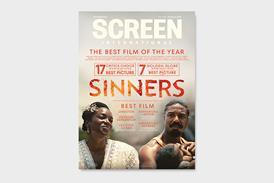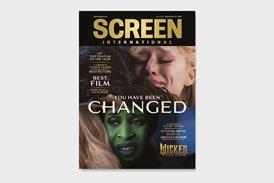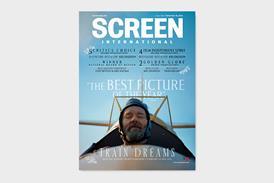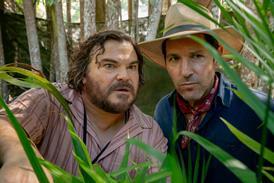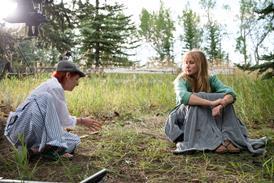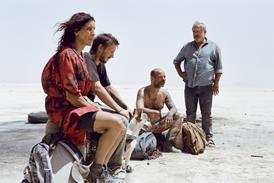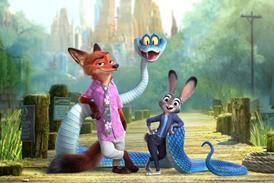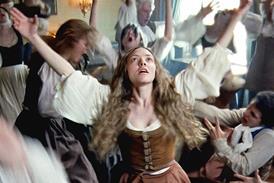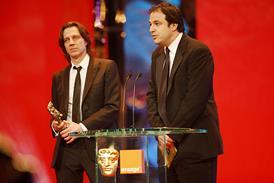Gerard Butler, Gal Gadot and Jason Momoa also star in Schnabel’s sprawling look at the Italian poet
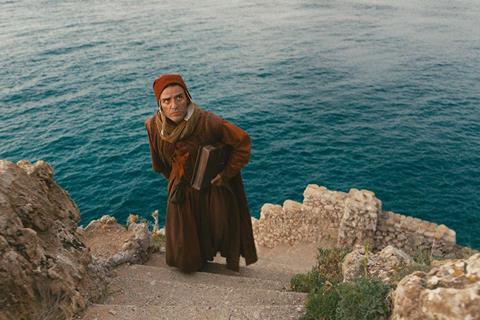
Dir: Julian Schnabel. US. 2025. 153mins
Artist-filmmaker Julian Schnabel could never be accused of lacking sheer enthusiasm and wild-eyed flamboyance. The gusto previously on display in the likes of Basquiat, Before Night Falls, and The Diving Bell And The Butterfly carries the all-out barmy, sometimes baffling In The Hand Of Dante, which both is and isn’t a film about Italy’s hallowed bard Dante Alighieri.
A rambling, free-associative feel
A sort of mock-biopic fantasia on both Dante and the late US writer Nick Tosches, the film flounders despite some entertaining and sometimes ripely décor-chomping performances. Sheer vigour, however intermittent, saves Schnabel from entering his own circle of cinematic Hell, but after the film’s Venice premiere, it risks floundering in commercial Purgatory.
Viewers expecting a straightforward portrayal of Dante – as suggested by the opening images of Oscar Isaac, modelled on canonical depictions of the man – may be stymied by what follows, as the film jumps from Renaissance Italy to modern-day New Jersey. It mixes realistically mounted excerpts from Dante’s life, shot in colour, with black and white sequences following the fictionalised adventures of US scribe Nick Tosches. Schnabel and co-writer (and co-editor) Louise Kugelberg have in fact adapted a 2002 novel by Tosches – an esteemed journalist and writer best known for biographies of Jerry Lee Lewis and Dean Martin – in which the writer spins an elaborate autofictional fantasy about himself and Dante; both men played here by Oscar Isaac.
This Tosches is a streetwise tough cookie, first glimpsed as a teenager receiving a life lesson from his uncle (a ripe, raspy Al Pacino cameo) after stabbing another boy. A lover of Dante’s oeuvre, about which he holds forth rapturously in a diner scene, Tosches is recruited by the baddest of bad hombres – a mob boss (John Malkovich, irrepressibly acting from the scalp) and his horrible henchman Louie (Gerard Butler). Butler is hideously entertaining as an obnoxious, sewer-mouthed psychopath, and also plays a smirking Pope Boniface in the historical sequences – part of the film’s playful, if faintly gratuitous-seeming, game of doubles.
Tosches heads to Sicily in search of a legendary lost manuscript of Dante’s Divine Comedy written in the poet’s own hand – with Louie recklessly strewing a bloody trail of dead mafiosi and librarians alike. Meanwhile, back in the 12th and 13th centuries, an intermittent sequence of scenes depict moments from Dante’s life; their import and continuity not always evident to anyone who hasn’t taken the time to bone up on key Renaissance events. Central to this strand is an extended cameo by the film’s executive producer Martin Scorsese, no less, wearing a huge white Gandalf beard as the mysterious sage Isaiah.
Gal Gadot flits in and out, playing both Dante’s wife Gemma (who got the short straw in his life, being the sister of his famously beloved Beatrice) and as present-day Giulietta, Tosches’s stand-in secretary and eventual love interest. In the former role, Gadot is fairly inert; in the latter, simmering and flirtatious, and increasingly in her element as the film becomes a sort of international action thriller. A white-suited, white-fedora’d Jason Momoa looms as the ‘final boss’ heavy, with Sabrina Impacciatore (The White Lotus season 2) as an academic who will do anything to ensure the success of her thesis.
By the time the film’s composer, pop artist Benjamin Clementine, appears holding forth in grandly Shakespearean vein as the mysterious ‘Mephistopheles’, it’s quite clear that we’ve spun way beyond the parameters of conventional narrative coherence – although the sheer larkiness is intermittently heady in its own way. Clementine’s score, mixing lush orchestrations and delicate piano, is as unashamedly wayward as the film itself.
The historical content is elegantly mounted, production designer Paki Meduri excelling with relatively limited resources. But these sequences feel stilted and theatrical, especially given the high fustian tenor of the period dialogue – not that the contemporary strand doesn’t itself feature some poetic flights of exaltation.
The film, as is often the case with Schnabel, has a rambling, free-associative feel, although here the impressionistic inserts – including skyscapes and time-lapse close-ups of flowers – are not quite as organically integrated as usual. He also seems, on sheer whim, to drop in blasts of the Rolling Stones, Canned Heat, and Sam the Sham and the Pharaohs (the timeless ‘Wooly Bully’) – but who can argue with such fleeting touches of earthly Paradise?
Production companies: DreamCrew Entertainment, MeMo Films, TWIN Pictures, ArtOfficial Productions
International sales: WME, filmsalesinfo@wmeagency.com
Producers: Jon Kilik, Francesco Melzi d´Éril, Olmo Schnabel, Gabriele Bebe Moratti, Vito Schnabel, Julian Schnabel
Screenplay: Julian Schnabel, Louise Kugelberg, based on the book by Nick Tosches
Cinematography: Roman Vasyanov
Production design: Paki Meduri
Editing: Marco Spoletini, Louise Kugelberg
Music: Benjamin Clementine
Main cast: Oscar Isaac, Gal Gadot, Gerard Butler, John Malkovich

